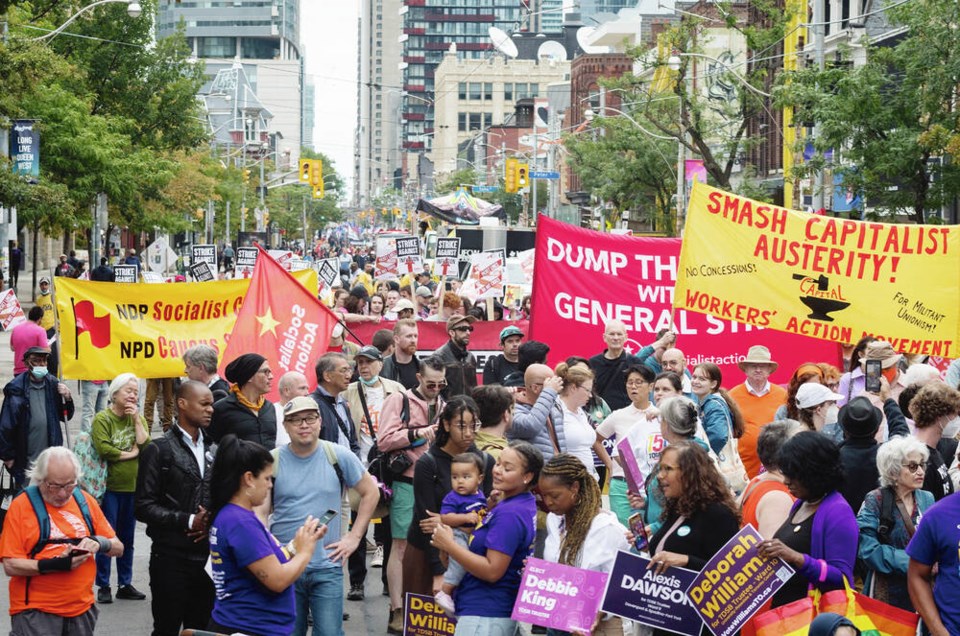We Canadians really enjoy an extra day off work, but we also feel a little bad about it, worried somebody is missing out while we get paid to stay home and barbecue in our pyjamas.
This contradictory, “yay-boo” feeling is just part of our national character, like saying sorry all the time and hating Trudeau no matter what the guy says or does. It also explains why so many of our statutory holidays are named with “contranyms,” illogical words that are their own opposites, like “cleave” (to split apart AND to bring together) and “oversight” (watchful supervision AND error of omission).
This month we double-down on the yay-boo Canadian feeling with two contranym holidays: Labour Day (when we do not labour), and National Day for Truth and Reconciliation (when we [insert your own explanation, which I guarantee will make people mad]).
Labour Day has been a statutory public holiday in Canada since 1894 and, as the saying goes, is as Canadian as possible under the circumstances. It is celebrated on the first Monday of September, even in Quebec, where it is called Fête du Travail, or “travel feet,” if I remember my high school French correctly.
On paper, Labour Day officially celebrates workers and the labour union movement, but in practice we think of it more as the a) final reliably good BBQ weather; b) end of sweet freedom (school starts on Tuesday); and c) last chance to wear white shoes without withering old-lady disapproval.
The explanation for this latter sartorial aspect of Labour Day (old ladies WILL frown at you!) is that white used to be a summer colour, and Labour Day unofficially marks the end of summer.
In the early 20th century, the unofficial rule about wearing white was intended as a status symbol for new members of the middle class, as it created an opportunity for stepping on the necks of any neighbours who weren’t quite as middle class as you.
Today we do this by taking out breathtakingly unsustainable loans to buy university educations and avocado sandwiches that we can’t afford.
But back to the origins of Labour Day, a very different time in Canada when the average working man laboured in ways that seem impossible and unbelievable today. Granted, since the pandemic I have become used to working from home in my underwear so my expectations re: employment might be a little off, but in the late 19th century, workers had to fight to work less than 12 HOURS PER DAY!
The “Nine Hour Movement” was an international effort to standardize shorter working days (nine hours in Canada and Britain, eight hours in the U.S., 45 minutes in France). It began in Hamilton, Ontario in 1872 and spread to Toronto, where it really took hold in the Toronto Typographical Union, an early Canadian trade union in the printing industry, so they got a good deal on leaflets and newsletters.
Among other activities, the union organized a strike on March 25, 1872, known as the Toronto printers’ strike. A few weeks later, a demonstration was held to show solidarity among the workers of Toronto, which included a parade of 2,000 workers, headed by marching bands. By the time the parade reached Queen’s Park, the sympathetic crowd had grown to 10,000.
Neither the strike nor the parade were well-received by employers, who generally felt that, all in all, they would prefer not to reduce workers’ hours, pay workers more, improve safety or, you know, do anything at all.
More specifically, they had 23 union leaders and strike organizers arrested for conspiracy, brought to trial and thrown into prison. At the time, disrupting a commercial enterprise with a strike was no different in law from any other conspiracy to disturb the peace — union activity was considered a criminal activity.
Whoa … typing that sent chills down my back. I got this creepy feeling that somehow Elon Musk is now paying attention.
Let’s move on, because the prime minister of the day, Sir John A. Macdonald, came to the rescue of the Nine Hour Movement and the jailed strike committee members. I know today we are supposed to despise Sir John and take down his statue and complain about distant past whatnot, but there is no doubt that he was responsible for passing the Trade Unions Act on June 14, 1872, legalizing and protecting union activity in Canada.
After 1872, almost every union’s demands included the nine-hour day and the 54-hour week, which sounds awful today but keep in mind nobody back then had to sit at a laptop in their kitchen for Zoom meetings with their supervisor.
The fight of the Toronto printers had a second, lasting legacy. The annual parades held in support of the Nine Hour Movement and the printers’ strike eventually pressured Prime Minister John Thompson to declare a national labour holiday in 1894, making Labour Day official.
So, yay-boo. Most of us will enjoy the extra day off, even though we feel a little guilty about this contranym holiday, and the other one at the end of the month. It’s OK: we’re complicated and contradictory and so is our history, full of made-up middle class dress rules and demanding employers and checkered prime ministers.
It’s OK: We’re Canadian, eh?
>>> To comment on this article, write a letter to the editor: [email protected]


